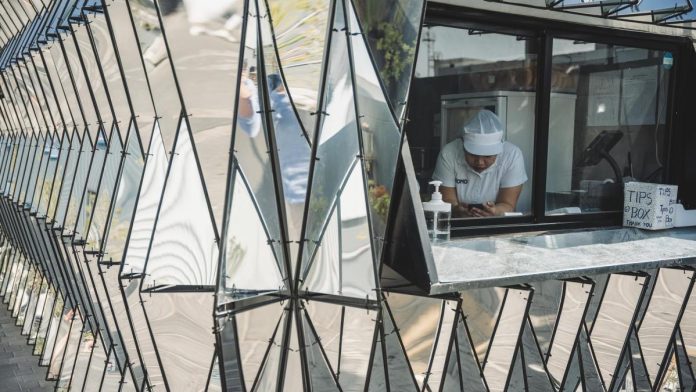To get to Alserkal Avenue from Downtown Dubai, take a taxi along the straight Sheikh Zayed Road. The emirate's super-wide, six-lane main traffic artery in both directions is lined with multi-story glass car salons, filled to the brim with luxury cars polished to a high gloss.
As you drive past, all the Bentleys, Ferraris and Bugattis in their shop windows look strangely unreal, like little Matchbox cars in the showcase of a passionate collector.
A different Dubai presents itself on Alserkal Avenue. Instead of glittering super skyscrapers, unspectacular warehouses are grouped at right angles over an area of 45,000 square meters. The usual graffiti can be seen, you could also be in Berlin or Brooklyn.
The baroque angel on the street corner is still irritating. Completely weathered, with faded paintwork, it stands alone in the blazing hot midday sun, a BMW 502 from the 1950s that is certainly no longer roadworthy.
Because of his lush lines, he was given the nickname “Baroque Angel”. What is such a classic of German automobile history doing in an industrial district of Dubai?
Modern art scene and a workshop for vintage cars
In less than 15 years, Alserkal Avenue has become the center of Dubai's modern art scene. Thanks to a businessman's idea of renting out an entire block of discarded warehouses in the Al Quoz industrial region to artists, a creative urban center has emerged with 25 exciting galleries and studios, unusual fashion stores, design studios, arthouse cinemas with plush sofas, hip cafes and pop -up restaurants.
And a workshop for restoring old cars. The BMW 502 is still on the waiting list for a rebirth as a neat classic car. In the nostalgia workshop next door, they currently have their hands full screwing and welding on two-seater English sports convertibles and massive American road cruisers.
A few steps down the street you can admire successful results in the “360carmuseum”. These include a beautiful Jaguar E, the 1920 Ford T Hod Rod, a 1964 Cadillac Fleetwood Sedan and a midnight black Citroën Traktion Avant, known from old French gangster films. Even a GDR racing car called the Trabant 601 was given the honor of being an exhibit in Dubai's new cultural hotspot.
A creative district like Shoreditch, London
Not far from the Auto-Temple, Italian custom-made shoes are handmade, a performance and dance theater invites you to perform, and yoga and meditation studios invite you to relax. If you like unusual sneakers, check out “thegoodlife”. The Odd Piece is a treasure trove of locally restored furnishings, most of which come from souks or antique shops.
“What is important to us is this special mix and atmosphere that can be found in art districts all over the world, whether in Shoreditch in London or in the Meatpacking District in Manhattan,” explains project manager Charlotte York.
In addition, Alserkal Avenue sees itself as a platform where Dubai's creative scene can meet and network with one another. The A4 Space, for example, is very popular as a so-called co-working café. Every day, creative people sit there in front of their laptops, enjoy their cappuccino, and exchange ideas with other guests.
An early pioneer in the converted industrial complex, the Ayyam Gallery is worth more than just a look. It supports Syrian artists whose works deal with the themes of war and homeland. The Green Art Gallery, in turn, exhibits emerging regional artists. The Leila Heller Gallery shows contemporary works from the Middle East and Asia.
The food culture is also not neglected on Alserkal Avenue. The organic restaurant Appetite has a loyal vegan community, and the Mirzam chocolate factory impresses with its sweet temptations.
Participation in the trip was supported by Dubai Tourism. Our standards of transparency and journalistic independence can be found at here.


